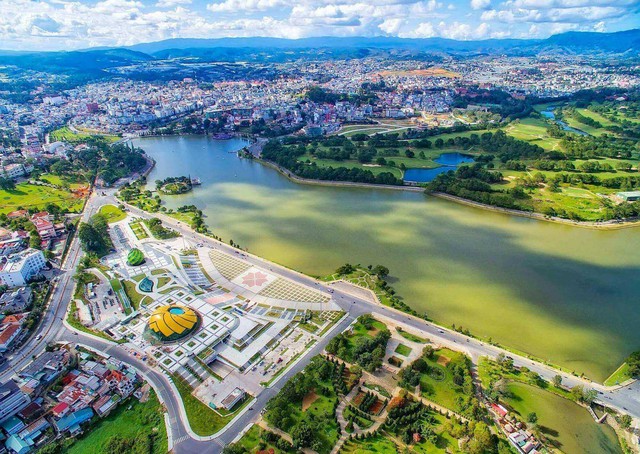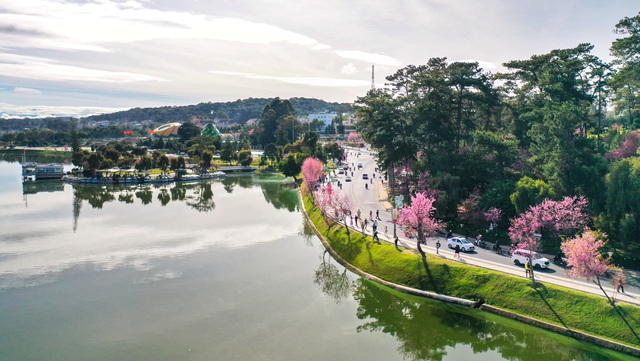
With over 130 years old, Da Lat (Lam Dong province) is a famous tourist city in Vietnam, located on the Lam Vien plateau at an altitude of 1,500 meters above sea level. During the French colonial period, Da Lat had over 1,300 villas with diverse architecture, mostly in the northern French style, thus being called “little Paris”.
The planning of Lam Dong province in the period of 2021 – 2030, with a vision until 2050, has been approved by the Prime Minister, stating that by 2045, Lam Dong will become a centrally-run city consisting of 3 districts, 3 towns, and 3 communes.
According to the approved roadmap, by 2025, Lam Dong will integrate Lac Duong district into Da Lat city. Lac Duong town will become a ward of Da Lat city.
After the merger, the natural area of Da Lat city will increase from 391.15 km2 to 1,705.09 km2, more than 4.3 times. The population will also increase from 258,014 to 293,649. Accordingly, Da Lat city will have 22 administrative units, including 12 wards, 1 town, and 9 communes. Among them, the total of 12 wards also ensures the ratio of the number of wards to the total number of administrative units as prescribed. The new city will have administrative boundaries adjacent to two provinces, Khanh Hoa and Dak Lak.
According to the aforementioned plan, by 2045, Da Lat city will become a district, part of the inner city area of centrally-run Lâm Đồng.
With the expanded scale of 1,707km2, Da Lat will become the largest district in the country, 13.6 times larger than the current largest district in Vietnam, O Mon (Can Tho City) – 125.4km2.
The scale of “Da Lat district” in the future will be larger than 13 provinces including Hai Duong, Hai Phong, Da Nang, Nam Dinh, Hau Giang, Thai Binh, Vinh Long, Can Tho, Ninh Binh, Vinh Phuc, Hung Yen, Ha Nam, Bac Ninh.
A world-class city
According to the aforementioned plan, Da Lat in the future will become a high-quality tourist center of the country and the Southeast Asian region, an educational center, an innovation and creativity hub; developing a modern, high-class, and internationally recognized night-time economy.

With a natural area 4.3 times larger and a population increase of nearly 40,000 people, the expansion of Da Lat will have more potential to develop tourism, culture, service sectors, trade, and supporting industries for tourism. However, the merger also poses many challenges for Da Lat, especially in terms of environmental protection and sustainable urban development.
Prior to that, according to the overall adjustment task of the general planning of Da Lat city and its surrounding areas until 2045, which was approved by the Prime Minister in March 2023, in the future, Da Lat, considering expansion, will include 6 satellite towns, with the existing city as the administrative center, high-end resort tourism, and preservation of architectural heritage. The population scale of Da Lat and its surrounding areas until 2035 is about 1,100,000 – 1,150,000 people; until 2045 is about 1,900,000 – 1,950,000 people.
The adjustment document also notes that the locality needs to anticipate upcoming projects that Lam Dong is implementing to meet the new development requirements of the city such as expressways, airports. Notably, it includes the relationship between Da Lat and its surrounding areas with Bao Loc City; between Lien Khuong Airport, the Phan Rang – Da Lat railway line, and the system of expressways, national highways, etc.
This aims to solve the problem of traffic congestion, the urban space that is being disrupted, especially in the core area of Da Lat; preventing the core area of Da Lat from being “distorted” by the strong wave of real estate investment and immigration.
In addition, the city’s People’s Committee is also orienting the development of an evening economy model in the area until 2030. Specifically, by the end of 2023, 4 night-time economic models will be implemented including: Water Music Park at Da Lat Flower Park; Food street in the Trần Lê Street and Hoàng Văn Thụ Lake area; Night street in Hoa Binh, Ba Thang Hai, Truong Cong Dinh, Tang Bat Ho, Nguyen Chi Thanh areas; Park-plaza-book street complex in the Xuan Huong Park.
In the period of 2023 – 2030, with 4 night-time economic models: Pedestrian street – from the intersection of Đinh Tiên Hoàng – Trần Quốc Toản to the Flower Park with a length of about 1,600 m; night market in the Ánh Sáng Park area; Open space park – Exhibition house – Street of books in Xuan Huong Park; Complex of tourist sites such as Love Valley, Dream Hill, Thong Nhat Hill.
Future development direction for 7 night-time economic models such as: Hoa Binh Central Ward, Trần Quốc Toản Park, Lu Gia Residential Area, Tuyen Lam Lake National Tourist Area, Prenn Lake Tourist Area, New Cam Ly Residential Area, Pedestrian street along Cam Ly Stream.












